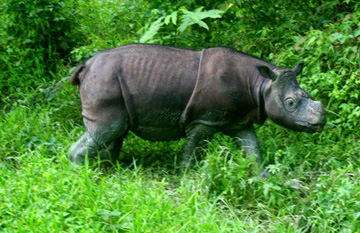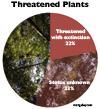On Friday, October 29th, 193 member nations of the Convention on Biological Diversity (CBD) reached a possibly landmark agreement on saving the world’s suffering biodiversity in Nagoya, Japan. The agreement was especially notable after nations failed—by all accounts—to live up to the goals from the previous CBD agreement, including stemming the global loss of biodiversity by 2010. According to scientists, the world’s species continue to vanish at mass-extinction rates due to habitat loss, deforestation, overconsumption, pollution, climate change, and invasive species. To addresses this crisis the new CBD agreement sets out 20 goals for 2020. But given the global challenges in saving the world’s species and the lack-of-teeth in agreement (it is strictly voluntary), will the CBD make a difference or in ten years time will goals be again unmet and life on planet Earth worse off than ever? To answer this mongabay.com turned to a number of experts in the conservation world.
“Speaking with one voice, 193 nations of the [CBD] renewed their call for coordinated international action to address the biodiversity crisis and provided useful targets, guidance, and financial resources to expedite national-level planning and actions,” senior economist, John Talberth, with World Resources Institute’s People and Ecosystems Program, summed-up.
“The simple fact that an agreement was reached at all is a major achievement. After last year’s failure of the climate change conference in Copenhagen, many people thought global cooperation on environmental issues was dead. This CBD agreement proves it’s not,” says Taylor Ricketts, World Wildlife Fund (WWF) Managing Director of the Conservation Science Program, said.
 Black-crested macaque (Macaca nigra) is classified by the IUCN Red List as Critically Endangered. Photo by: Rhett A. Butler. |
But, the most optimistic view of the agreement was put forth by Lina Barrera, Director of Biodiversity and Ecosystem Services Policy with Conservation International (CI), who told mongabay.com: “we don’t see any major weaknesses of the agreement.”
Strengths
All three experts agree that one of the major strengths of the new agreement is its specificity.
“Nations have publicly committed to protecting their biodiversity in much more specific terms than ever before,” says Ricketts with WWF. “Ten years ago the commitments in the CBD agreement were much more general and vague. This time, 20 specific targets have been outlined for 2020.”
Such targets include halving the current loss in species habitat, such as forests; placing 10% of the world’s oceans (up from about 1 percent now) under protection; and protecting 17% of the world’s terrestrial environments (up from 12% currently).
Barrera of CI calls the protected areas agreements “very encouraging”, adding that the “terrestrial target makes positive steps while strengthening the mandate to focus on the highest-priority areas, and the ten-fold increase of the marine target is particularly ambitious.”
Still, these targets were not as high as many conservationists hoped for, or as high as experts say is necessary to stem the loss in biodiversity.
“We’d like to see the target for increasing protection of areas important for biodiversity and ecosystem services to be more ambitious in the coming years. Our analyses show that we need to protect at least 25% of land and 15% of the oceans by 2020, in order to slow and optimally halt the loss of biodiversity,” says Barrera.
 A captive Critically Endangered Panamanian golden frog (Atelopus zeteki) with froglet. The species is on the edge of extinction and has vanished from much of its range. Photo by: Rhett A. Butler. |
Talberth is even more critical of these targets, which have received considerable media attention since the meeting. For example, he argues that science shows at least 20% of the ocean (double the current target) must be protected to safeguard the world’s marine life.
“It would be better to develop targets for protected areas based on scientific analysis of what it actually will take to maintain viable populations of endangered, threatened, and at risk species through networks of protected areas, buffers zones, and landscape linkages rather proposing simple targets of generic ‘protected’ areas,” he says, adding that not all protected areas are equal.
“Protected areas have a huge range of effectiveness, only GAP Status 1 protected areas have enough backbone to prevent biodiversity loss, and so the protected areas strategy called for in the agreement should focus on protected areas of this caliber.”
According to the International Union for the Conservation of Nature (IUCN) GAP Status 1 means “permanent protection from conversion of natural land cover and a mandated management plan in operation to maintain a natural state.”
How much of the world’s land and oceans are set aside under protection—and the strength of these protections—will certainly be one of the key goals to watch over the next ten years. But experts said the agreement had made progress on other areas.
Ricketts from WWF says that agreement was notable for recognizing “linkages between biodiversity and human well-being”.
 The Sumatran orangutan (Pongo abelii) is considered Critically Endangered with approximately 7,000 left, representing an 80% decline in 75 years. Photo by: Rhett A. Butler. |
“The agreement repeatedly stresses the importance of nature in providing food and medicines, in regulating climate and water supplies, in pollinating crops, etc.,” he says. “It’s clear that countries understand that protecting biodiversity is important for its own sake, but also for the sake of their citizens. This is promising, because it makes it more likely that countries will follow through on the targets.”
Talberth adds that contentious wrangling over the agreement on Access and Benefit Sharing (ABS) proved especially fruitful. By all accounts, the conflict over ABS was one of the most difficult aspects of the agreement to achieve consensus.
“The commitment to implement the Nagoya Protocol on Access to Genetic Resources and the Fair and Equitable Sharing of Benefits Arising from their Utilization is an historic step in protecting traditional knowledge, reversing bio-piracy and improving indigenous community access to and control over genetic and biodiversity resources,” says Talberth.
Other strengths, according to the conservationists, were pledges to eliminate subsidies that have proven harmful for biodiversity, the plan to include biodiversity considerations into national accounts and development strategies, and acknowledging the impacts of climate change.
“Healthier ecosystems are often more resilient to climate change, buffering climate change impacts and helping us adapt,” explains Ricketts.
Weaknesses
Almost everyone agrees that even if not perfect, the new agreement is an improvement on the prior one made in 2002. Of course, given the large-scale failure of the last agreement to spur the necessary from governments to safeguard biodiversity—and prevent further losses—a little improvement may not be enough. In fact, WRI economist John Talberth bluntly told mongabay.com that while the agreement had particular strengths, it wouldn’t do much to improve the state of biodiversity in the short-term.
“Loss of biodiversity is a crisis that calls for emergency response. The agreement, however, is process heavy, unenforceable, slow, and a bit too flexible,” Talberth says.
 Researchers estimate that 250 Sumatran rhino survive in the world. This captive individual is a subspecies known as the Bornean rhino, of which only 40 or so survive. Photo by: Jeremy Hance. |
He explains that the agreement simply doesn’t address the biodiversity crisis in the right way, especially given the magnitude of the problem.
“Scientists estimate the loss of biodiversity between 5,000 and 30,000 species a year. Most of these species are unknown, and even for the ones we know about, we have very little information about their current population size and distribution, life cycle habitat needs, extinction drivers, and mechanisms to eliminate these drivers as soon as possible. Even for charismatic megafauna—like polar bears, tigers, and orangutans, our collective inability to respond swiftly and effectively to save populations depleted to thousands or just hundreds of individuals overshadows anything we are doing.”
So what should be done? According to Talberth: “we need an emergency response […] that focuses international attention and resources more specifically on saving species on the brink now rather than waiting for additional international or national level biodiversity planning processes to play out.”
Along this line, Talberth argues that the “key failing” of the agreement is that it relies completely on national biodiversity action plans, instead of “focusing on what international institutions can do directly to combat the crisis.”
He explains that “there is no guarantee that national biodiversity strategies or actions plans will actually be completed, nor is there assurance that if they are, they will not significantly depart from the [CBD’s] Strategic Plan and its targets.”
In other words, now that the agreement has been signed 193 nations are allowed to pursue the CBD’s goals in 193 different ways. While this allows for local control, it is unlikely to actually save species facing a barrage of threats, some local, some regional, and some global, all of them urgent.
On specifics in the agreement, Talberth says that target to halt habitat loss by 50% is not adequate: instead this goal “should be strengthened to call for immediate cessation of loss of the most critical and endangered habitats, such as those identified by global biodiversity ‘hot spot’ analyses.”
 The black-and-white ruffed lemur (Varecia variegata) population has dropped by 80% in 27 years. This species is also listed as Critically Endangered. Photo by: Rhett A. Butler. |
For Ricketts, the agreement, like so many international initiatives, is threatened by lack of funding. While Ricketts compliments Japan for its last-minute pledge of $2 billion, which has been credited with restarting lagging talks, he says that if more countries don’t step up to adequately fund the goals, the agreement will become “another unfunded mandate for developing countries.”
Of course, the experts agree that the biggest weakness of an agreement like this is that it is strictly voluntary: there is no enforcement body and no penalties for a nation failing to uphold to its commitment.
“The only real penalty we can hope for, at this time, is public scrutiny to pressure governments to follow through and ask pointed questions if they don’t,” explains Ricketts. But for Ricketts such public scrutiny is unlikely if history is any indication.
“We failed spectacularly in meeting the 2010 target yet how much did everyone in the world hear about this? Without any visible public uproar, where is the pressure for countries to follow through on this new agreement?” he asks.
Barrera of CI puts the situation most starkly: “The real penalty for non-compliance [with the CBD agreement] will be the irreversible impacts on human society of losing biodiversity and the life sustaining services that it provides us.”
New understanding creates urgency
Despite the CBD agreement’s large shortcomings, the conservationists say that the meeting was infused by a deep sense of pressing importance.
“The urgency of the agreement is hard to miss, and indicates a level of seriousness we have not seen in quite a while. Agreeing on a set of measurable targets and outcomes all to be achieved in a fairly short period of time is another signal of this new level of concern,” Talberth says, calling this ‘urgency’ the “most beneficial aspect of the CBD agreement.
 The Critically Endangered Aruba island rattlesnake at the Bronx Zoo. Photo by: Rhett A. Butler. |
Ricketts says that a sea-change in understanding why biodiversity is important to the human community was one of the reasons behind the nations’ different attitudes this time around.
“In the past ten years I believe countries have become more aware that biodiversity supports the lives and livelihoods of their citizens, making me hopeful,” he says.
Barrera agrees: “I do think that there is a growing appreciation for how much people need biodiversity and a willingness to address the underlying drivers of its loss as well as take action for direct conservation.”
Ultimately it will be difficult to know the efficacy of the agreement until 2020 when the majority of its goals are supposed to be met. However, even if most of the CBD 2010 agreement’s goals are met—which would prove a huge success—it’s hard to imagine overall biodiversity will stabilize. The threats against the world’s species are so large—climate change, deforestation, and invasive species among others—that if the fight to save life on the Earth is to succeed, it will not only take many more decades of strategic, smart, and large-scale action, but massive changes in how global society currently operates from achieving true sustainability to viewing an intact natural world as necessary to human survival.
A selection of abridged goals from the CBD Agreement:
- Agreed to at least halve and where feasible bring close to zero the rate of loss of natural habitats including forests.
- Established a target of 17% of terrestrial and inland water areas and 10% of marine and coastal areas.
- To combat climate change, Governments will restore at least 15% of degraded areas through conservation or restoration..
- Will make special efforts to reduce the pressures faced by coral reefs by 2015.
- Safeguard at least 75% of threatened plant species in collections.
- Eliminate subsidies harmful to biodiversity.
- Take steps toward sustainable production and consumption.
- Eradicate or control invasive species or their pathways.
- Work with indigenous communities, respecting their knowledge and practices.
Related articles
Agreement reached at biodiversity summit
(10/29/2010) Delegates meeting in Nagoya, Japan, at the 10th Conference of the Parties (COP10) of the Convention on Biological Diversity (CBD) today agreed to take new steps to halt the global decline of biodiversity.
Harrison Ford chides US for spurning international biodiversity treaty
(10/28/2010) In a speech in Nagoya, Japan at the UN’s Convention for Biological Diversity (CBD) actor and conservationist, Harrison Ford, called on delegates to put aside differences and adopt a strong treaty to protect biodiversity. As a US citizen, he also urged his country to become a full signatory of the CBD. “The time has come for the United States to step up to the plate. The problem is so big and the time is so short, we have no choice. We have to act and we have to act now,” said Ford.
The march to extinction accelerates

(10/26/2010) A fifth of the world’s vertebrate species (i.e. mammals, birds, reptiles, amphibians, and fish) are threatened with extinction, according to a massive new study by the International Union for the Conservation of Nature (IUCN); and the situation is worsening for the world’s wildlife: on average 52 species of mammals, birds, and amphibians move one category closer to extinction every year (the IUCN Red List categorizes species as Least Concern, Near Threatened, Vulnerable, Endangered, Critically Endangered, Extinct in the Wild, and then Extinct). However, the news isn’t all bad. The study found that conservation action does work: in the first analysis of its kind, researchers found that the global biodiversity decline would have been 18% worse if not for conservation attention, “nonetheless,” the authors—174 scientists from 38 countries—write, “current conservation efforts remain insufficient to offset the main drivers of biodiversity loss.” According to the study, these drivers include agricultural expansion, logging, over-exploitation of species, and invasive species.
Losing nature’s medicine cabinet

(10/04/2010) In all the discussions of saving the world’s biodiversity from extinction, one point is often and surprisingly forgotten: the importance of the world’s species in providing humankind with a multitude of life-saving medicines so far, as well as the certainty that more vital medications are out there if only we save the unheralded animals and plants that contain cures unknown. Already, species have provided humankind everything from quinine to aspirin, from morphine to numerous cancer and HIV-fighting drugs. “As the ethnobotanist Dr. Mark Plotkin commented, the history of medicine can be written in terms of its reliance on and utilization of natural products,” physician Christopher Herndon told mongabay.com. Herndon is co-author of a recent paper in the journal Biotropica, which calls for policy-makers and the public to recognize how biodiversity underpins not only ecosystems, but medicine.
Mass extinction fears widen: 22 percent of world’s plants endangered

(09/28/2010) Scientific warnings that the world is in the midst of a mass extinction were bolstered today by the release of a new study that shows just over a fifth of the world’s known plants are threatened with extinction—levels comparable to the Earth’s mammals and greater than birds. Conducted by the Royal Botanic Gardens, Kew; the Natural History Museum, London; and the International Union for the Conservation of Nature (IUCN), the study is the first time researchers have outlined the full threat level to the world’s plant species. In order to estimate overall threat levels, researchers created a Sampled Red List Index for Plants, analyzing 7,000 representative species, including both common and rare plants.
Why biodiversity is worth saving
(09/23/2010) In recognition of the United Nations’ declaration of 2010 as the ‘International Year of Biodiversity’, the Association for Tropical Biology and Conservation (ATBC) has included a special section on the biodiversity in its September 2010 issue of Biotropica.
21% of Africa’s freshwater plants and animals threatened
(09/02/2010) 21 percent of African freshwater plant and animal species are threatened with extinction, according to a five year assessment of 5,167 freshwater species by 200 scientists.